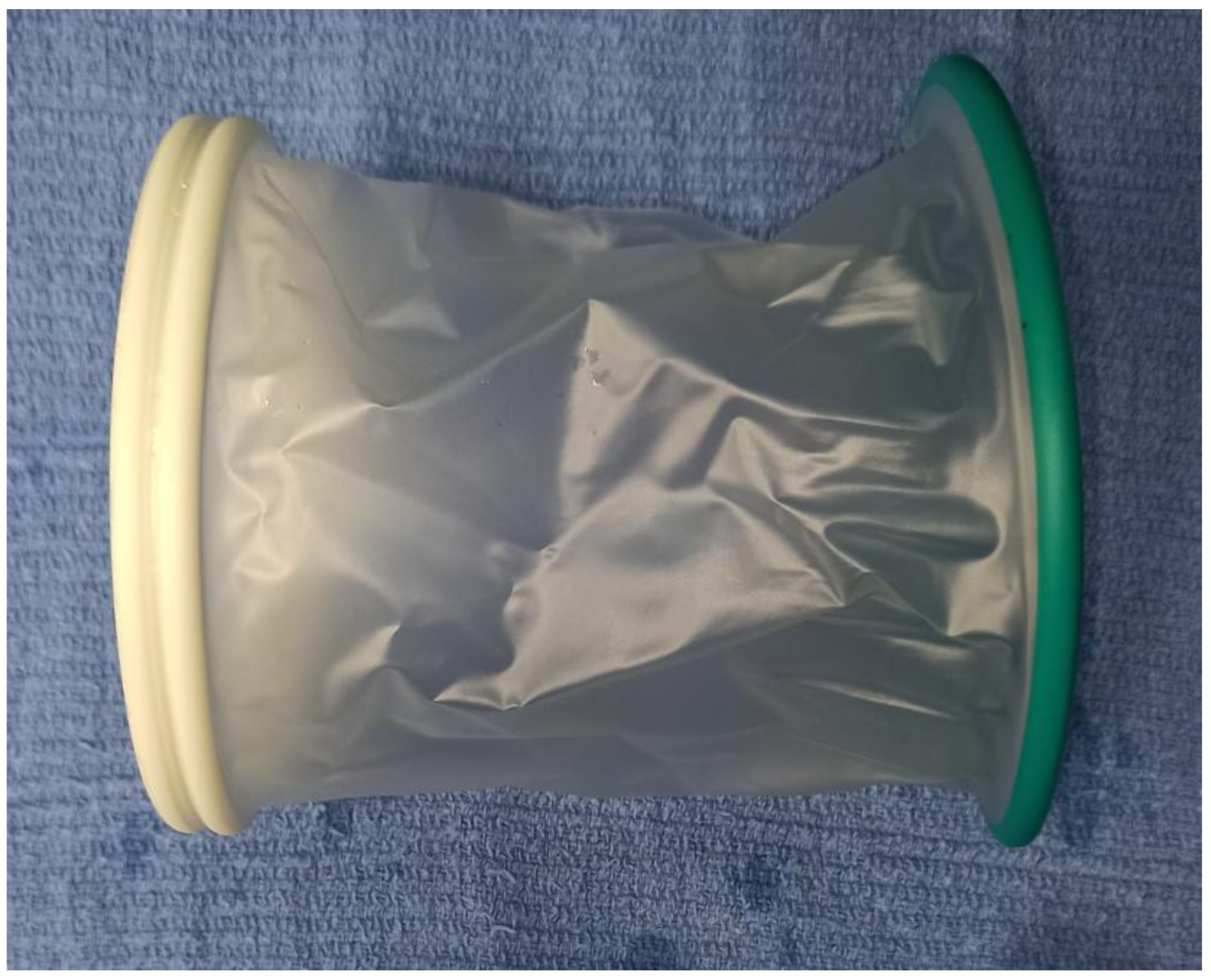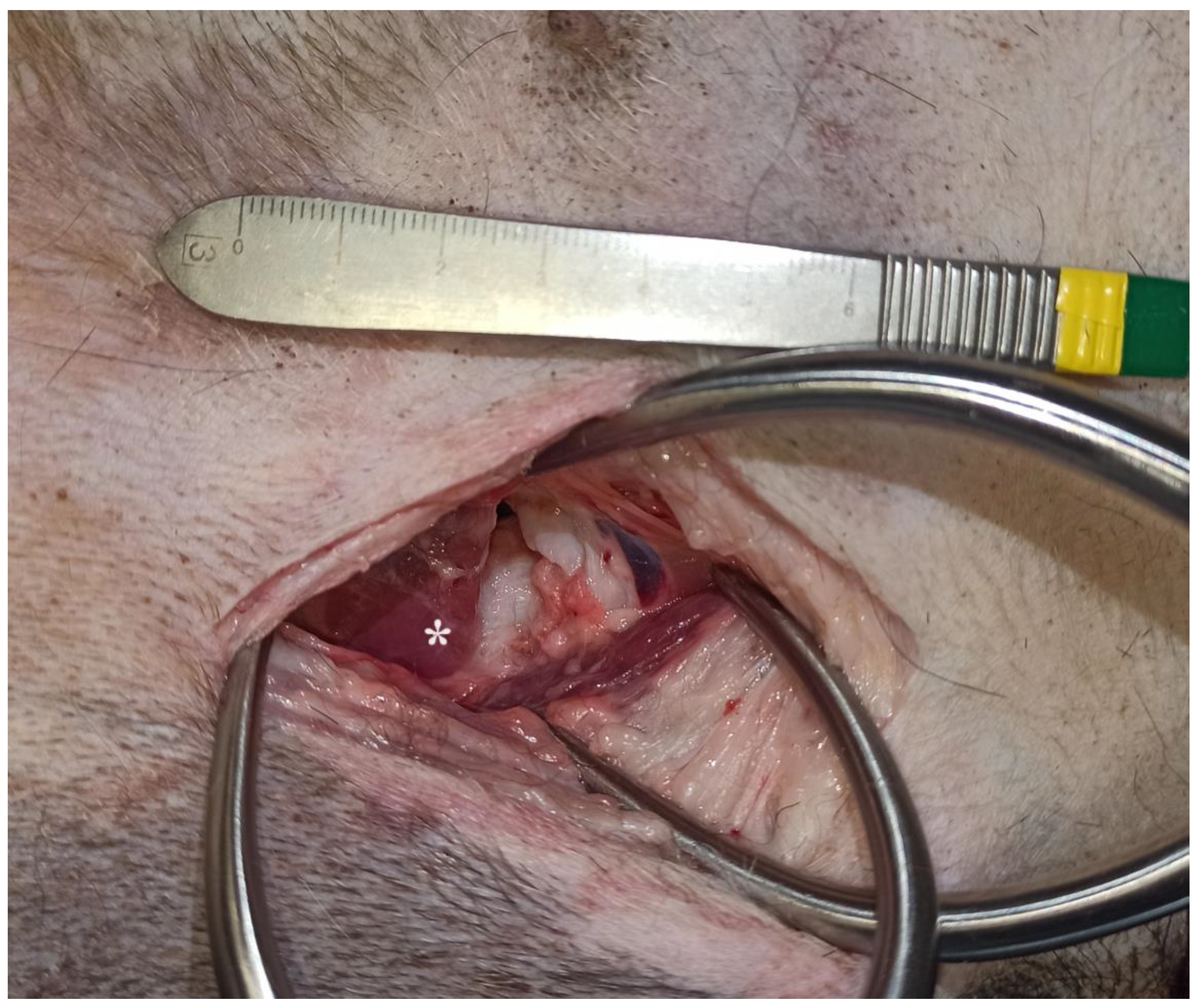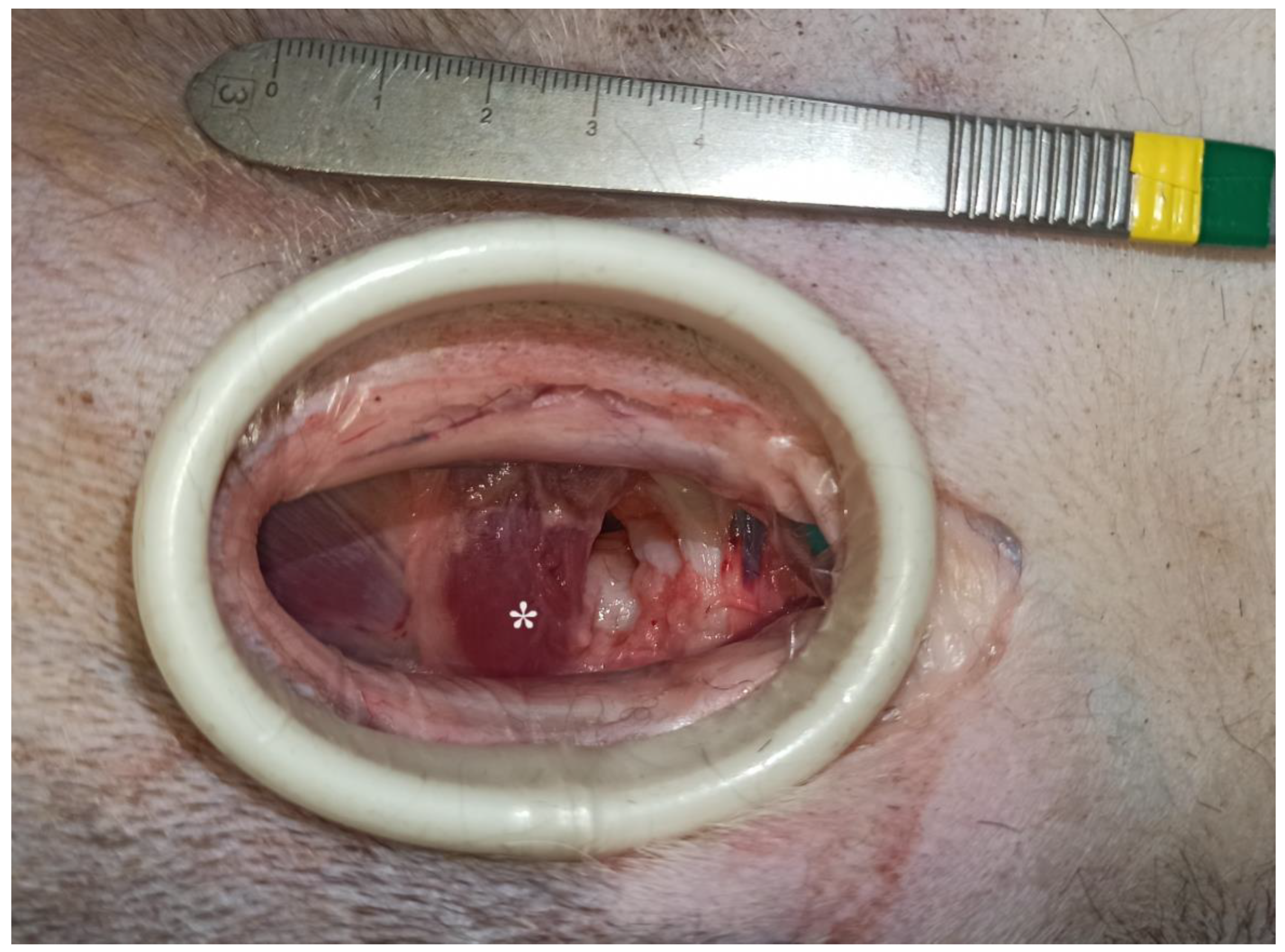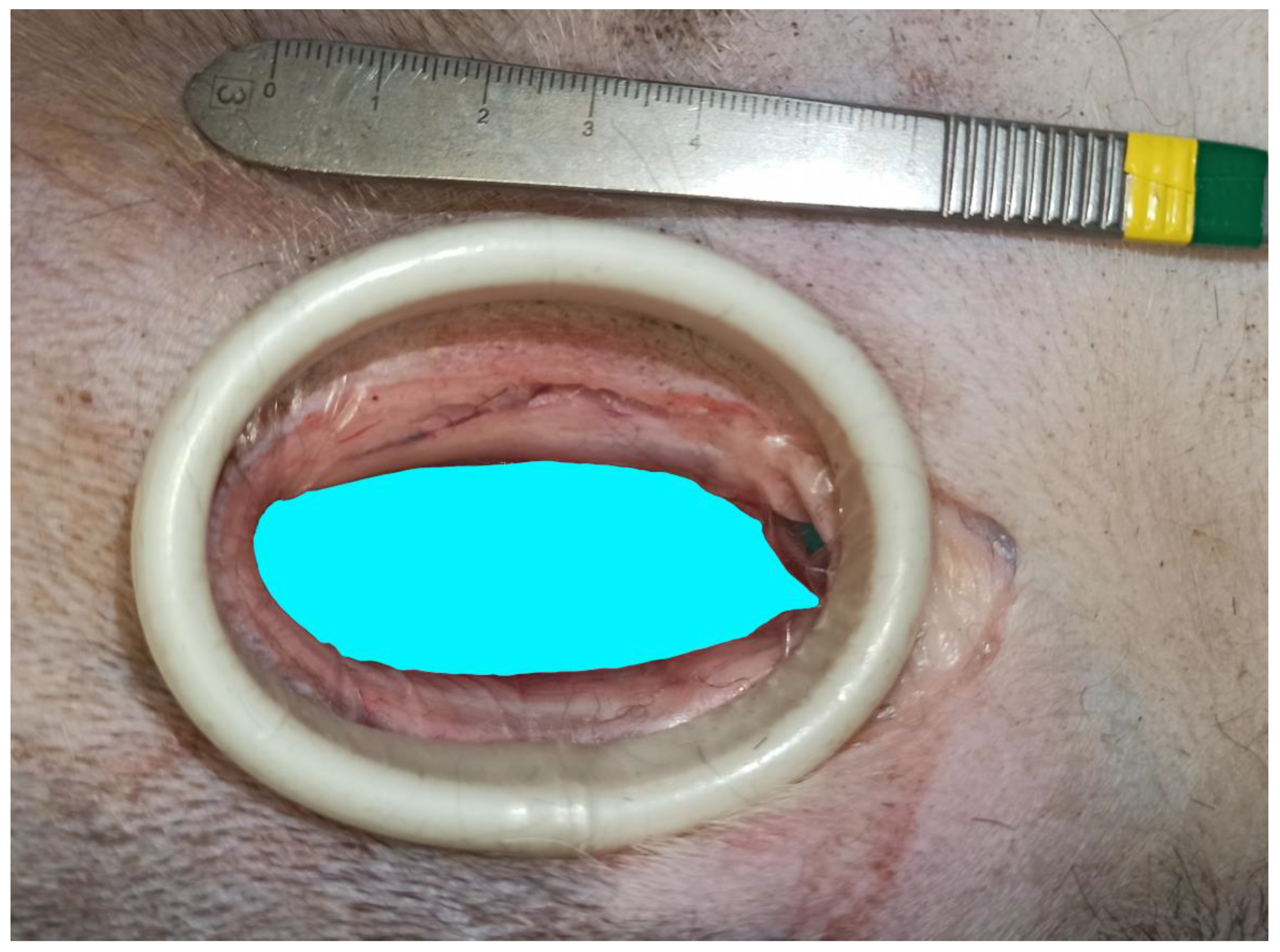Comparison of the Ventral Approach to the Canine Hip Joint Using Gelpi Retractors and an Elastic O-Ring Wound Retractor
Abstract
Simple Summary
Abstract
1. Introduction
2. Materials and Methods
Statistical Methods
3. Results
4. Discussion
5. Conclusions
Author Contributions
Funding
Institutional Review Board Statement
Data Availability Statement
Conflicts of Interest
References
- Crumplin, M.K.H. Hand-held surgical retractors. BJS 2023, 110, 1120–1121. [Google Scholar] [CrossRef] [PubMed]
- Trębacz, P.; Galanty, M. Prepubic minilaparotomy as the surgical approach in the treatment of prostate disorders in dogs. A Cadaver Study. J. Vet. Res. 2012, 56, 677–680. [Google Scholar] [CrossRef]
- Mayhew, P.; Mayhew, K.; Shilo-Benjamin, Y.; Kass, P.; Pascoe, P. Prospective evaluation of access incision position for minimally invasive surgical organ exposure in cats. J. Am. Vet. Med. Assoc. 2014, 245, 1129–1134. [Google Scholar] [CrossRef] [PubMed]
- Horiuchi, T.; Tanishima, H.; Tamagawa, K.; Matsuura, I.; Nakai, H.; Shouno, Y.; Tabuse, K. Randomized, controlled investigation of the anti-infective properties of the Alexis retractor/protector of incision sites. J. Trauma 2007, 62, 212–215. [Google Scholar] [CrossRef] [PubMed]
- Tsunezuka, Y.; Oda, M.; Moriyama, H. Wound retraction system for lung resection by video-assisted mini-thoracotomy. Eurp. J. Cardio. Thorac. Surg. 2006, 29, 110–111. [Google Scholar] [CrossRef]
- Lacitignola, L.; Laricchiuta, P.; Imperante, A.; Acquafredda, C.; Stabile, M.; Scardia, A.; Guadalupi, M.; Vicenti, C.; Crovace, A.; Staffieri, F. Wound Retractor Laparoscopic Port System for Laparoscopic Ovariectomy in Panthera leo. Animals 2022, 12, 700. [Google Scholar] [CrossRef]
- Alvarez-Pinzon, A.M.; Mutnal, A.; Suarez, J.C.; Jack, M.; Friedman, D.; Barsoum, W.K.; Patel, P.D. Evaluation of wound healing after direct anterior total hip arthroplasty with use of novel retraction device. Am. J. Orthop. 2015, 44, 17–24. [Google Scholar]
- Guerrero, T.G.; Koch, D.; Montavon, P.M. Fixation pf a proximal femoral physeal fracture in a dog using a ventral approach and two Kirschner wires. Vet. Comp. Orthop. Traumatol. 2005, 2, 110–114. [Google Scholar]
- Venzin, C.; Montavon, P.M. Augmentation of the transverse acetabular ligament in canine caudoventral hip luxation. Vet. Comp. Orthop. Traumatol. 2007, 20, 320–323. [Google Scholar] [CrossRef]
- Blackford Winders, C.L.; Vaughn, W.V.; Birdwhistell, K.E.; Holsworth, I.G.; Franklin, S.P. Accuracy of femoral head and neck excision via a craniolateral approach or a ventral approach. Vet. Comp. Orthop. Traumatol. 2018, 31, 102–107. [Google Scholar] [CrossRef]
- Rohner, D.; Forterre, S.; Rohbach, H.; Bürki, A.; Grgas, D.; Howard, J.; Forterre, F. Influence of two types of self-retaining retractors on multifidus muscle blood flow during dorso lateral thoracolumbar hemilaminectomy in dogs. Vet. Comp. Orthop. Traumatol. 2015, 28, 256–262. [Google Scholar] [CrossRef] [PubMed]
- Nuss, K.M.R.; Auer, J.A.; Boos, A.; Von Rechenberg, B. An animal model in sheep for biocompatibility testing of biomaterials in cancellous bones. BMC Musculoskelet. Disord. 2006, 7, 67. [Google Scholar] [CrossRef] [PubMed]
- Pang, L.; Watanabe, K.; Toyama, Y.; Matsumoto, M. Massive hemothorax caused by Gelpi retractor during posterior correction surgery for adolescent scoliosis surgery: A case report. Scoliosis 2014, 9, 1–4. [Google Scholar] [CrossRef] [PubMed][Green Version]
- Moretti, G.; Birettoni, F.; Caivano, D.; Nannarone, S.; Crovace, A.; Porciello, F.; Bufalari, A. Mini-invasive approach for removal of iliopsoas migrating grass awns with an atraumatic wound retractor. J. Small Anim. Pract. 2019, 62, 150–155. [Google Scholar] [CrossRef] [PubMed]
- Trębacz, P.; Frymus, J.; Galanty, M. Double-wound o-ring retraction for chylothorax surgery in dogs. Animals 2023, 13, 2567. [Google Scholar] [CrossRef]
- Lois-Ortega, Y.; García-Curdi, F.; Brotons-Durbán, S.; Vendrell-Marqués, J.B. Use of Alexis Retractor in Thyroid and Parathyroid Surgery Innovation In Surgical Technique. Cirugía Española (Engl. Ed.) 2019, 97, 46–49. [Google Scholar] [CrossRef]
- Mubeen, S.; Mubeen, S.; Falconer, D. Use of the Alexis ring retractor in oral and maxillofacial surgery. Br. J. Oral. Maxillofac. Surg. 2014, 52, 470–472. [Google Scholar] [CrossRef]
- Perenyei, M.; Dobbs, T.D.; Fraser, L.R.; Winter, S.C. Use of the self-retaining Alexis ring retractor in transoral robotic surgery. Head Neck 2017, 39, 2132–2134. [Google Scholar] [CrossRef]
- Waring, G.J.; Shawer, S.; Hinshaw, K. The use of O-ring retractors at Caesarean section: A systematic review and meta-analysis. Eur. J. Obstet. Gynecol. Reprod. Biol. 2018, 228, 209–214. [Google Scholar] [CrossRef] [PubMed]
- Adamska, D.; Wojciechowska, M.; Kopański, Z. Protecting wound edges from infection using an Alexis wound retractor. J. Publ. Health Nurs. Med. Resc. 2012, 3, 57–61. [Google Scholar]
- Weese, J.S. A review of postoperative infections in veterinary orthopaedic surgery. Vet. Comp. Orthop. Traumatol. 2008, 21, 99–105. [Google Scholar] [CrossRef] [PubMed]
- Cheng, K.P.; Roslani, A.C.; Sehha, N.; Kueh, J.H.; Law, C.W.; Chong, H.Y.; Arumugam, K. ALEXIS O-Ring wound retractor vs conventional wound protection for the prevention of surgical site infections in colorectal resections(1). Color. Dis. 2012, 14, e346–e351. [Google Scholar] [CrossRef] [PubMed]
- Capolupo, G.T.; Lauricella, S.; Mascianà, G.; Caricato, C.; Angeletti, S.; Ciccozzi, M.; Coppola, R.; Caricato, M. O-Ring Protector in Prevention of SSIs in Laparoscopic Colorectal Surgery. JSLS 2019, 23, e2019.00048. [Google Scholar] [CrossRef] [PubMed]
- Salgado-Nesme, N.; Morales-Cruz, M.; Navarro-Navarro, A.; Patiño-Gómez, T.A.; Vergara-Fernández, O. Usefulness of a circumferential wound retractor in emergency colorectal surgery as a preventive measure for surgical site infection. Alexis O-Ring® and emergency surgery. Rev. Gastroenterol. Mex (Engl. Ed.) 2020, 85, 399–403. [Google Scholar] [CrossRef] [PubMed]
- Hinkson, L.; Siedentopf, J.P.; Weichert, W.; Henrich, W. Surgical site infection in cesarean sections with the use of a plastic sheath wound retractor compared to the traditional self-retaining metal retractor. Eur. J. Obstet. Gynecol. Reprod. Biol. 2016, 203, 232–238. [Google Scholar] [CrossRef]
- Mothiba, M.S.; Tshepuwane, T.C.; Adefolalu, A.O.; Monokoane, T.S. Alexis O-ring wound retractor versus traditional metal retractors for the prevention of postcaesarean surgical site infections. S. Afr. Fam. Pract. 2023, 65, e1–e6. [Google Scholar] [CrossRef]
- Lohsiriwat, V.; Lohsiriwat, D. Atraumatic O-ring wound retractor reduces postoperative pain. Tech. Coloproctol. 2014, 18, 1177–1178. [Google Scholar] [CrossRef]
- Lauricella, S.; Caricato, M.; Mascianà, G.; Ciccozzi, M.; Angeletti, S.; Capolupo, G.T. Cost-effectiveness analysis of O-Ring wound retractor in elective laparoscopic colorectal surgery. Ann. Ital. Chir. 2021, 92, 460–464. [Google Scholar]





| Cadaver Characteristics | Side | Area in cm2 (Pixels) a Obtained Using Retractors: | |
|---|---|---|---|
| Gelpi | O-Ring (O-WR) | ||
| Crossbreed, female, 28 kg | Left | 2.72 (27,166) | 4.84 (48,400) |
| Right | 3.09 (30,877) | 4.18 (41,787) | |
| Crossbreed, female, 30 kg | Left | 4.35 (43,501) | 7.13 (71,332) |
| Right | 6.52 (65,188) | 5.97 (59,689) | |
| Bernese mountain dog, male, 37 kg | Left | 6.12 (61,199) | 6.46 (64,583) |
| Right | 5.78 (57,824) | 7.98 (79,788) | |
| German Shepherd, male, 38 kg | Left | 6.50 (64,999) | 5.29 (52,936) |
| Right | 7.19 (71,927) | 7.08 (70,800) | |
| American Staffordshire terrier, male, 29 kg | Left | 6.56 (65,609) | 6.51 (65,120) |
| Right | 5.34 (53,410) | 5.28 (52,752) | |
| Crossbreed, female, 35 kg | Left | 6.97 (69,705) | 5.20 (52,028) |
| Right | 7.94 (79,373) | 5.99 (59,934) | |
| German Shepherd, female, 32 kg | Left | 6.16 (61,604) | 4.43 (44,301) |
| Right | 6.54 (65,420) | 4.13 (41,319) | |
| Crossbreed, male, 40 kg | Left | 5.70 (56,992) | 6.64 (66,445) |
| Right | 9.70 (97,013) | 10.77 (107,711) | |
| Gordon setter, male, 45 kg | Left | 7.54 (75,394) | 5.14 (51,428) |
| Right | 8.71 (87,076) | 7.27 (72,666) | |
| Crossbreed, male, 25 kg | Left | 7.59 (75,908) | 10.46 (104,584) |
| Right | 4.64 (46,354) | 6.10 (60,978) | |
| Descriptive statistics | |||
| Arithmetic mean ± standard deviation (range) | Left | 6.02 ± 1.49 (2.72–7.6) | 6.21 ± 1.74 (4.43–10.46) |
| Right | 6.54 ± 1.96 (3.09–9.70) | 6.48 ± 1.96 (4.13–10.77) | |
| Overall | 6.28 ± 1.72 (2.72–9.70) | 6.34 ± 1.81 (4.13–10.77) | |
Disclaimer/Publisher’s Note: The statements, opinions and data contained in all publications are solely those of the individual author(s) and contributor(s) and not of MDPI and/or the editor(s). MDPI and/or the editor(s) disclaim responsibility for any injury to people or property resulting from any ideas, methods, instructions or products referred to in the content. |
© 2023 by the authors. Licensee MDPI, Basel, Switzerland. This article is an open access article distributed under the terms and conditions of the Creative Commons Attribution (CC BY) license (https://creativecommons.org/licenses/by/4.0/).
Share and Cite
Trębacz, P.; Frymus, J.; Pawlik, M.; Czopowicz, M.; Barteczko, A.; Kurkowska, A.; Zdeb, K.; Galanty, M. Comparison of the Ventral Approach to the Canine Hip Joint Using Gelpi Retractors and an Elastic O-Ring Wound Retractor. Animals 2023, 13, 3582. https://doi.org/10.3390/ani13223582
Trębacz P, Frymus J, Pawlik M, Czopowicz M, Barteczko A, Kurkowska A, Zdeb K, Galanty M. Comparison of the Ventral Approach to the Canine Hip Joint Using Gelpi Retractors and an Elastic O-Ring Wound Retractor. Animals. 2023; 13(22):3582. https://doi.org/10.3390/ani13223582
Chicago/Turabian StyleTrębacz, Piotr, Jan Frymus, Mateusz Pawlik, Michał Czopowicz, Anna Barteczko, Aleksandra Kurkowska, Krzysztof Zdeb, and Marek Galanty. 2023. "Comparison of the Ventral Approach to the Canine Hip Joint Using Gelpi Retractors and an Elastic O-Ring Wound Retractor" Animals 13, no. 22: 3582. https://doi.org/10.3390/ani13223582
APA StyleTrębacz, P., Frymus, J., Pawlik, M., Czopowicz, M., Barteczko, A., Kurkowska, A., Zdeb, K., & Galanty, M. (2023). Comparison of the Ventral Approach to the Canine Hip Joint Using Gelpi Retractors and an Elastic O-Ring Wound Retractor. Animals, 13(22), 3582. https://doi.org/10.3390/ani13223582





